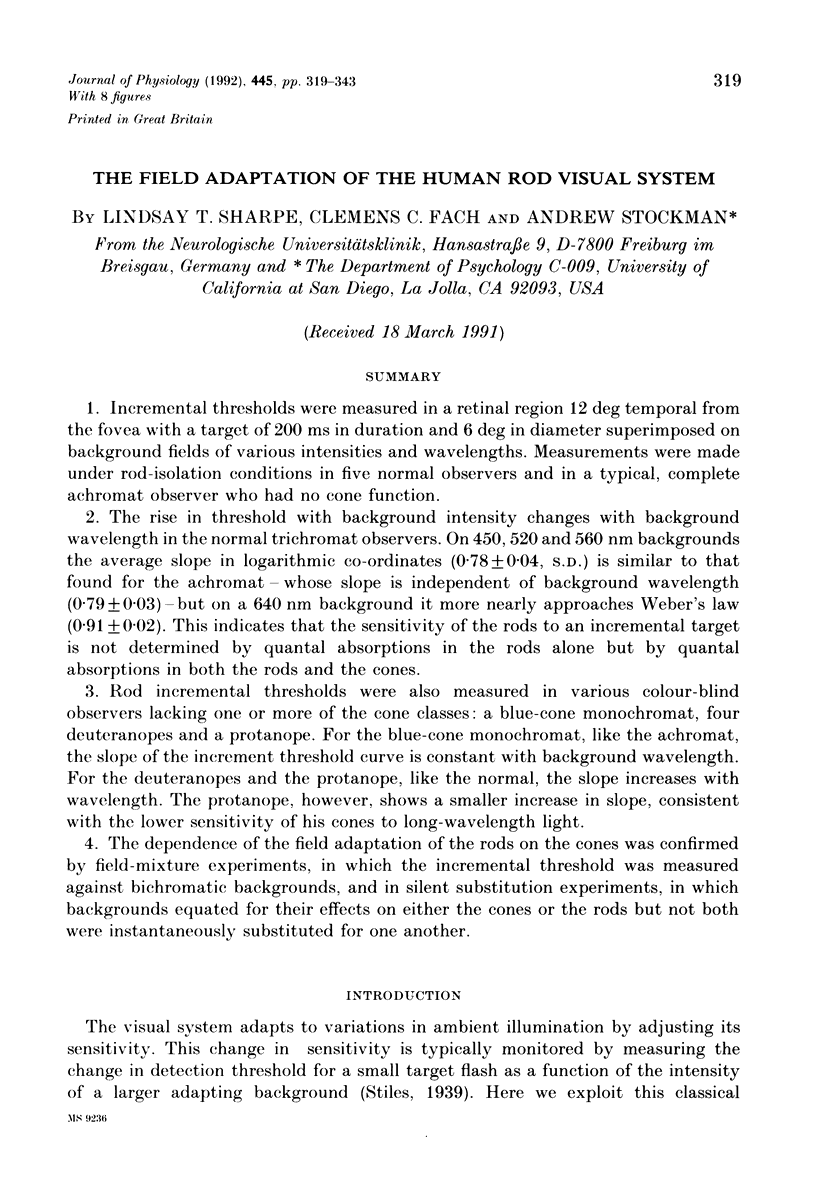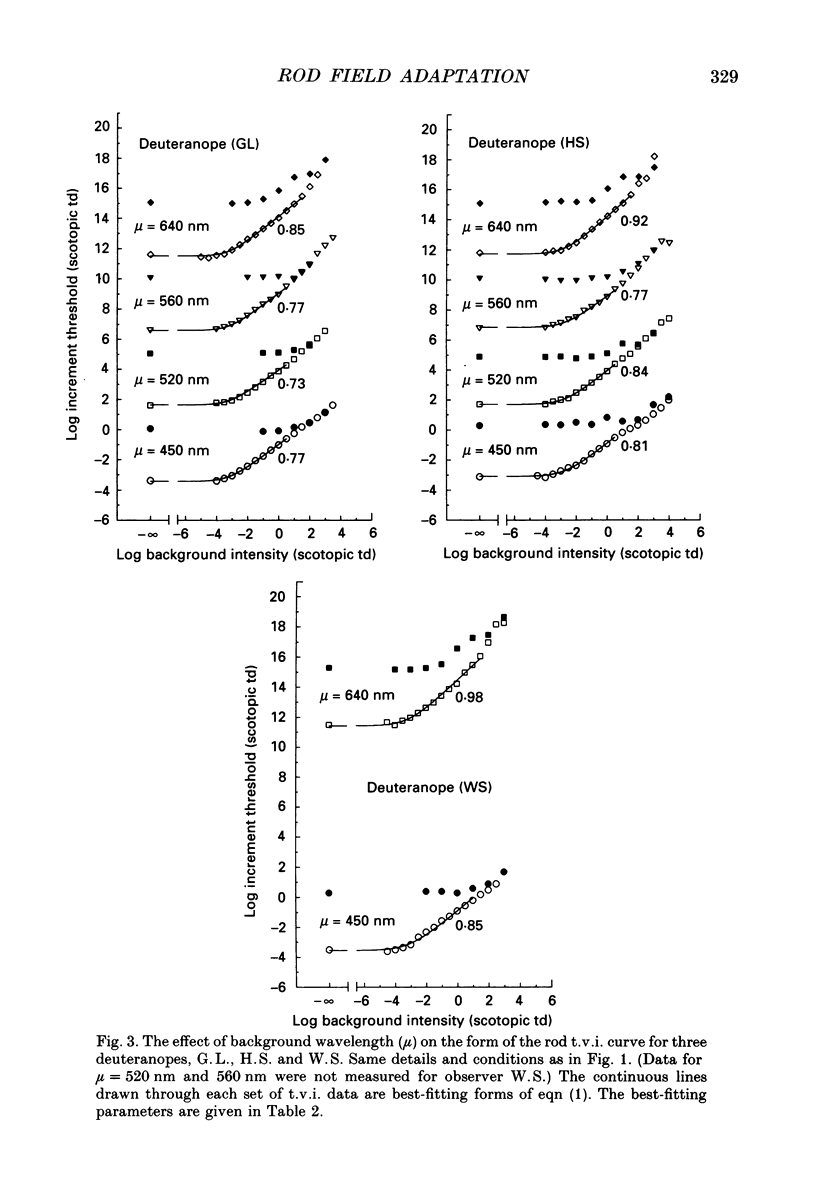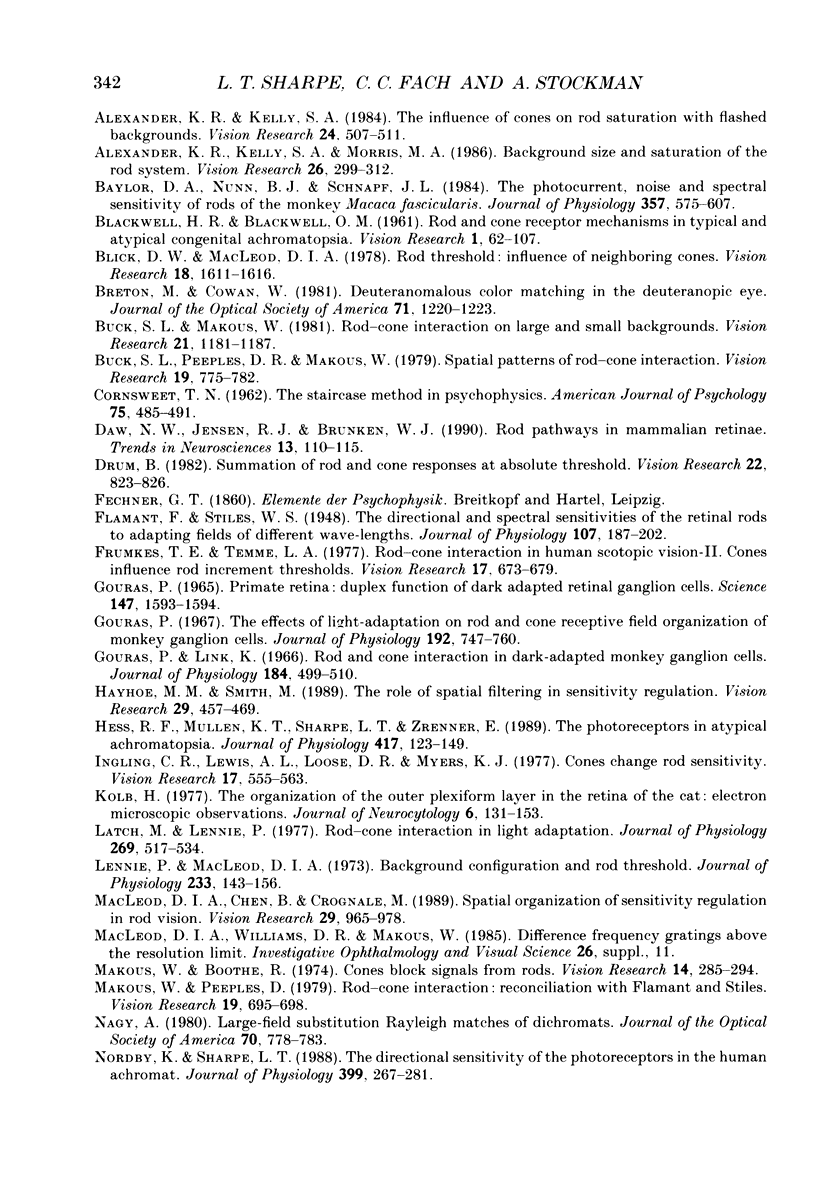Abstract
1. Incremental thresholds were measured in a retinal region 12 deg temporal from the fovea with a target of 200 ms in duration and 6 deg in diameter superimposed on background fields of various intensities and wavelengths. Measurements were made under rod-isolation conditions in five normal observers and in a typical, complete achromat observer who had no cone function. 2. The rise in threshold with background intensity changes with background wavelength in the normal trichromat observers. On 450, 520 and 560 nm backgrounds the average slope in logarithmic co-ordinates (0.78 +/- 0.04, S.D.) is similar to that found for the achromat--whose slope is independent of background wavelength (0.79 +/- 0.03)--but on a 640 nm background it more nearly approaches Weber's law (0.91 +/- 0.02). This indicates that the sensitivity of the rods to an incremental target is not determined by quantal absorptions in the rods alone but by quantal absorptions in both the rods and the cones. 3. Rod incremental thresholds were also measured in various colour-blind observers lacking one or more of the cone classes: a blue-cone monochromat, four deuteranopes and a protanope. For the blue-cone monochromat, like the achromat, the slope of the increment threshold curve is constant with background wavelength. For the deuteranopes and the protanope, like the normal, the slope increases with wavelength. The protanope, however, shows a smaller increase in slope, consistent with the lower sensitivity of his cones to long-wavelength light. 4. The dependence of the field adaptation of the rods on the cones was confirmed by field-mixture experiments, in which the incremental threshold was measured against bichromatic backgrounds, and in silent substitution experiments, in which backgrounds equated for their effects on either the cones or the rods but not both were instantaneously substituted for one another.
Full text
PDF
























Selected References
These references are in PubMed. This may not be the complete list of references from this article.
- Adelson E. H. Saturation and adaptation in the rod system. Vision Res. 1982;22(10):1299–1312. doi: 10.1016/0042-6989(82)90143-2. [DOI] [PubMed] [Google Scholar]
- Alexander K. R., Kelly S. A., Morris M. A. Background size and saturation of the rod system. Vision Res. 1986;26(2):299–312. doi: 10.1016/0042-6989(86)90027-1. [DOI] [PubMed] [Google Scholar]
- Alexander K. R., Kelly S. A. The influence of cones on rod saturation with flashed backgrounds. Vision Res. 1984;24(5):507–511. doi: 10.1016/0042-6989(84)90048-8. [DOI] [PubMed] [Google Scholar]
- Baylor D. A., Nunn B. J., Schnapf J. L. The photocurrent, noise and spectral sensitivity of rods of the monkey Macaca fascicularis. J Physiol. 1984 Dec;357:575–607. doi: 10.1113/jphysiol.1984.sp015518. [DOI] [PMC free article] [PubMed] [Google Scholar]
- Blick D. W., MacLeod D. I. Rod threshold: influence of neighboring cones. Vision Res. 1978;18(12):1611–1616. doi: 10.1016/0042-6989(78)90252-3. [DOI] [PubMed] [Google Scholar]
- Breton M. E., Cowan W. B. Deuteranomalous color matching in the deuteranopic eye. J Opt Soc Am. 1981 Oct;11(10):1220–1223. doi: 10.1364/josa.71.001220. [DOI] [PubMed] [Google Scholar]
- Buck S. L., Makous W. Rod-cone interaction on large and small backgrounds. Vision Res. 1981;21(7):1181–1187. doi: 10.1016/0042-6989(81)90021-3. [DOI] [PubMed] [Google Scholar]
- Buck S. L., Peeples D. R., Makous W. Spatial patterns of rod-cone interaction. Vision Res. 1979;19(7):775–782. doi: 10.1016/0042-6989(79)90153-6. [DOI] [PubMed] [Google Scholar]
- CORNSWEET T. N. The staircrase-method in psychophysics. Am J Psychol. 1962 Sep;75:485–491. [PubMed] [Google Scholar]
- Daw N. W., Jensen R. J., Brunken W. J. Rod pathways in mammalian retinae. Trends Neurosci. 1990 Mar;13(3):110–115. doi: 10.1016/0166-2236(90)90187-f. [DOI] [PubMed] [Google Scholar]
- Drum B. Summation of rod and cone responses at absolute threshold. Vision Res. 1982;22(7):823–826. doi: 10.1016/0042-6989(82)90014-1. [DOI] [PubMed] [Google Scholar]
- Flamant F., Stiles W. S. The directional and spectral sensitivities of the retinal rods to adapting fields of different wave-lengths. J Physiol. 1948 Mar 15;107(2):187–202. doi: 10.1113/jphysiol.1948.sp004262. [DOI] [PMC free article] [PubMed] [Google Scholar]
- Frumkes T. E., Temme L. A. Rod-cone interaction in human scotopic vision--II. Cones influence rod increment thresholds. Vision Res. 1977;17(6):673–679. doi: 10.1016/s0042-6989(77)80001-1. [DOI] [PubMed] [Google Scholar]
- GOURAS P. PRIMATE RETINA: DUPLEX FUNCTION OF DARK-ADAPTED GANGLION CELLS. Science. 1965 Mar 26;147(3665):1593–1594. doi: 10.1126/science.147.3665.1593. [DOI] [PubMed] [Google Scholar]
- Gouras P., Link K. Rod and cone interaction in dark-adapted monkey ganglion cells. J Physiol. 1966 May;184(2):499–510. doi: 10.1113/jphysiol.1966.sp007928. [DOI] [PMC free article] [PubMed] [Google Scholar]
- Gouras P. The effects of light-adaptation on rod and cone receptive field organization of monkey ganglion cells. J Physiol. 1967 Oct;192(3):747–760. doi: 10.1113/jphysiol.1967.sp008328. [DOI] [PMC free article] [PubMed] [Google Scholar]
- Hayhoe M. M., Smith M. V. The role of spatial filtering in sensitivity regulation. Vision Res. 1989;29(4):457–469. doi: 10.1016/0042-6989(89)90009-6. [DOI] [PubMed] [Google Scholar]
- Hess R. F., Mullen K. T., Sharpe L. T., Zrenner E. The photoreceptors in atypical achromatopsia. J Physiol. 1989 Oct;417:123–149. doi: 10.1113/jphysiol.1989.sp017794. [DOI] [PMC free article] [PubMed] [Google Scholar]
- Ingling C. R., Jr, Lewis A. L., Loose D. R., Myers K. J. Cones change rod sensitivity. Vision Res. 1977;17(4):555–563. doi: 10.1016/0042-6989(77)90054-2. [DOI] [PubMed] [Google Scholar]
- Kolb H. The organization of the outer plexiform layer in the retina of the cat: electron microscopic observations. J Neurocytol. 1977 Apr;6(2):131–153. doi: 10.1007/BF01261502. [DOI] [PubMed] [Google Scholar]
- Latch M., Lennie P. Rod-cone interaction in light adaptation. J Physiol. 1977 Aug;269(3):517–534. doi: 10.1113/jphysiol.1977.sp011912. [DOI] [PMC free article] [PubMed] [Google Scholar]
- Lennie P., MacLeod D. I. Background configuration and rod threshold. J Physiol. 1973 Aug;233(1):143–156. doi: 10.1113/jphysiol.1973.sp010302. [DOI] [PMC free article] [PubMed] [Google Scholar]
- MacLeod D. I., Chen B., Crognale M. Spatial organization of sensitivity regulation in rod vision. Vision Res. 1989;29(8):965–978. doi: 10.1016/0042-6989(89)90111-9. [DOI] [PubMed] [Google Scholar]
- Makous W., Boothe R. Cones block signals from rods. Vision Res. 1974 Apr;14(4):285–294. doi: 10.1016/0042-6989(74)90078-9. [DOI] [PubMed] [Google Scholar]
- Makous W., Peeples D. Rod-cone interaction: reconciliation with Flamant and Stiles. Vision Res. 1979;19(6):695–698. doi: 10.1016/0042-6989(79)90246-3. [DOI] [PubMed] [Google Scholar]
- Nordby K., Sharpe L. T. The directional sensitivity of the photoreceptors in the human achromat. J Physiol. 1988 May;399:267–281. doi: 10.1113/jphysiol.1988.sp017079. [DOI] [PMC free article] [PubMed] [Google Scholar]
- RUSHTON W. A. THE SENSITIVITY OF RODS UNDER ILLUMINATION. J Physiol. 1965 May;178:141–160. doi: 10.1113/jphysiol.1965.sp007620. [DOI] [PMC free article] [PubMed] [Google Scholar]
- RUSHTON W. A. VISUAL ADAPTATION. Proc R Soc Lond B Biol Sci. 1965 Mar 16;162:20–46. doi: 10.1098/rspb.1965.0024. [DOI] [PubMed] [Google Scholar]
- RUSHTON W. A., WESTHEIMER G. The effect upon the rod threshold of bleaching neighbouring rods. J Physiol. 1962 Nov;164:318–329. doi: 10.1113/jphysiol.1962.sp007024. [DOI] [PMC free article] [PubMed] [Google Scholar]
- Raviola E., Gilula N. B. Gap junctions between photoreceptor cells in the vertebrate retina. Proc Natl Acad Sci U S A. 1973 Jun;70(6):1677–1681. doi: 10.1073/pnas.70.6.1677. [DOI] [PMC free article] [PubMed] [Google Scholar]
- Sharpe L. T., Fach C., Nordby K., Stockman A. The incremental threshold of the rod visual system and Weber's law. Science. 1989 Apr 21;244(4902):354–356. doi: 10.1126/science.2711186. [DOI] [PubMed] [Google Scholar]
- Sternheim C. E., Glass R. A. Evidence for cone and rod contributions to common "adaptation pools". Vision Res. 1975 Feb;15(2):277–281. doi: 10.1016/0042-6989(75)90219-9. [DOI] [PubMed] [Google Scholar]
- Tamura T., Nakatani K., Yau K. W. Light adaptation in cat retinal rods. Science. 1989 Aug 18;245(4919):755–758. doi: 10.1126/science.2772634. [DOI] [PubMed] [Google Scholar]
- Wald G. HUMAN VISION AND THE SPECTRUM. Science. 1945 Jun 29;101(2635):653–658. doi: 10.1126/science.101.2635.653. [DOI] [PubMed] [Google Scholar]
- Zrenner E., Magnussen S., Lorenz B. Blauzapfenmonochromasie: Diagnose, genetische Beratung und optische Hilfsmittel. Klin Monbl Augenheilkd. 1988 Nov;193(5):510–517. doi: 10.1055/s-2008-1050292. [DOI] [PubMed] [Google Scholar]


